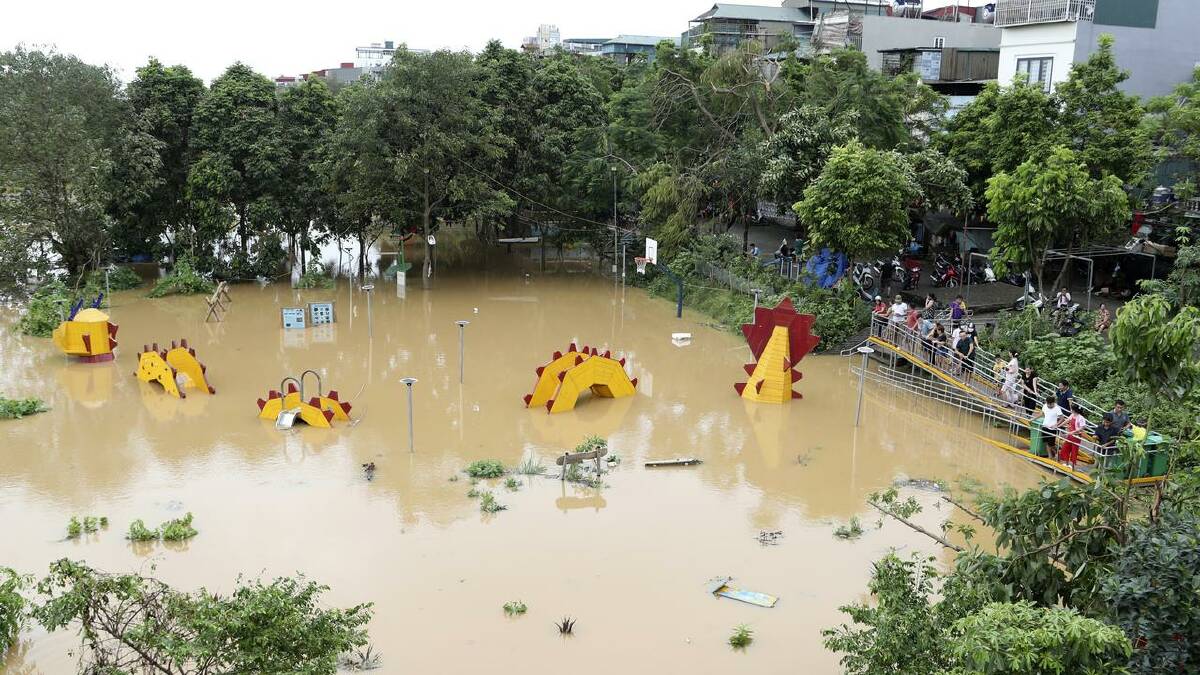
As Typhoon Yagi leaves 179 dead, Hanoi is inundated by a swollen river
The Red River, which was distended to a 20-year high, inundated the streets of Vietnam’s capital, Hanoi, resulting in the evacuation of thousands of residents. This occurred days after Typhoon Yagi devastated the northern region of the country, resulting in the deaths of at least 179 individuals.
Yagi, the most potent typhoon in Asia this year, caused the collapse of a bridge this week as it moved westward after making landfall on Saturday. It also swept through provinces along the Red River, the largest in the region.
Nguyen Van Hung, 56, a resident of a district situated on the banks of the Red River, stated, “My residence is now a component of the river.”
The government has estimated that 179 individuals have died and 145 are missing as a result of the typhoon and subsequent landslides and floods that occurred throughout the country.
EVN, the state-owned power utility of Vietnam, announced on Wednesday that it had disconnected power from certain flood-prone areas of the capital in order to maintain safety.
In a statement, Mai Van Khiem, the director of the National Center for Hydro-Meteorological Forecasting, stated that the Red River was at its highest level in two decades and that additional precipitation was anticipated over the next two days.
The government and state media have reported that thousands of residents of low-lying areas have been evacuated, and some schools in Hanoi have instructed pupils to remain at home for the remainder of the week.
After authorities issued a flood warning, the Blue Dragon Children’s Foundation, a charitable organization, evacuated its office in the vicinity of the city center on Tuesday.
“Speaker Carlota Torres Lliro expressed concern for the dozens of children and families residing in makeshift houses by the river, stating that people were moving frantically, relocating items, and moving their motorbikes.”
EVN announced on Wednesday that it had ceased the discharge of water from the Hoa Binh hydropower dam, the second largest in northern Vietnam, into the Da River, a tributary of the Red River, in order to decrease water levels.
On Wednesday, Vietnamese authorities also expressed apprehension regarding the release of water into the Lo River, a tributary of the Red River called Panlongjiang in China, by Chinese hydropower plants. Beijing stated that the two nations were collaborating on flood prevention.
EXPLOSION OF FACTORS
Yagi caused extensive damage to numerous factories and inundated warehouses in coastal export-oriented industrial hubs east of Hanoi, necessitating their closures. Executives anticipate that some of these hubs will only be able to recommence full operations after several weeks.
The disruptions pose a threat to global supply chains, as Vietnam is home to substantial multinational operations that primarily export goods to the United States, Europe, and other developed nations.
In provinces north of the capital, landslides caused by torrential floods resulted in the deaths of dozens of individuals.
Nguyen Duc Tam, a 40-year-old resident of Thai Nguyen, a city located approximately 60 km (37 miles) from Hanoi, stated, “The first floor of my residence is entirely submerged.”
“Now we have no fresh water and electricity,” according to him.
Hoang Hai Luan, a 30-year-old resident, stated that he had not encountered inundation of this magnitude in the vicinity in over two decades.
“My belongings and possibly those of many others are completely lost.”
A substantial facility for Samsung Electronics (005930.KS), which dispatches approximately half of its smartphones worldwide, is situated on the outskirts of the city of approximately 400,000 in Vietnam.
According to a witness from Reuters, the facility did not exhibit any indications of inundation on Wednesday.
All Categories
Recent Posts
Tags
+13162306000
zoneyetu@yahoo.com



